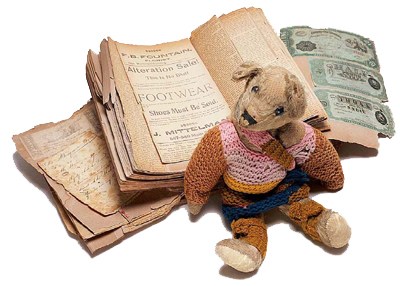Harvard offers a new on-line resource for anyone who has stuff worth keeping safe, such as photographs of one's wedding; or those fading newspaper accounts of the embezzler ancestor who fled to Canada to dig for gold and was killed in a barroom brawl; or that crumbling scrapbook assembled by an adolescent more than a century ago and bursting with ephemera ranging from beer tax stamps to an eighteenth-century bill of sale for a sloop. "A large body of popular and introductory literature on preservation topics has been published," says Jan Merrill-Oldham, Malloy-Rabinowitz preservation librarian in the University Library and the College Library, "and we wanted to help readers find their way to sources that are accurate and helpful."
 |
| Photograph by Jim Harrison |
The webography "Caring for Personal Collections" (at https://preserve.harvard.edu/
bibliographies/personalcollections.html) leads readers to on-line advice about care in general for all collection types and, specifically, for books and papers, photographs, postcards, scrapbooks, and audio and video materials, and ends with suggestions about how to work with a conservator.
The website includes, for instance, a link to a document created by the American Institute for Conservation of Historic and Artistic Works with this caution about the care of leatherbound books: "In the past, leather books were often oiled to improve their feel and appearance. Unfortunately dressings can also cause stains, make the leather sticky, and degrade paper. Recent tests have shown that dressings are only cosmetic and do nothing to prolong the life of the leather."
"Avoid powerful sources of heat, damp and pollution: don't store your valuable books, photos and paper in attics or basements, or near water sources like washing machines or bathrooms. Think about what's in the room above your heirlooms, too," warns the Northeast Document Conservation Center. Also, "if you want to keep a clipping from the newspaper for the long-term, have it photocopied onto buffered paper (e.g. Eucasta Waylite, Crane Weston Xerographic, or Howard Permalife). The copy will outlive the original."
"Materials and techniques commonly used in scrapbooks present real preservation challenges," the Iowa Conservation and Preservation Consortium acknowledges. "Generally it is wiser to leave the scrapbook as you inherited it rather than to try to improve on its construction methods. Attend to storage and handling; contact a conservator if you want to address repair problems."
To dust a teddy bear (as well as books, upholstery, baskets, and delicate fabrics), explains Heritage Preservation, "Vacuum on low suction, with the nozzle covered by cheesecloth and secured with a rubber band. This prevents tearing or pulling away loose bits of paper or fabric. Vacuum fabrics by gently patting the surface as if you were blotting it."




